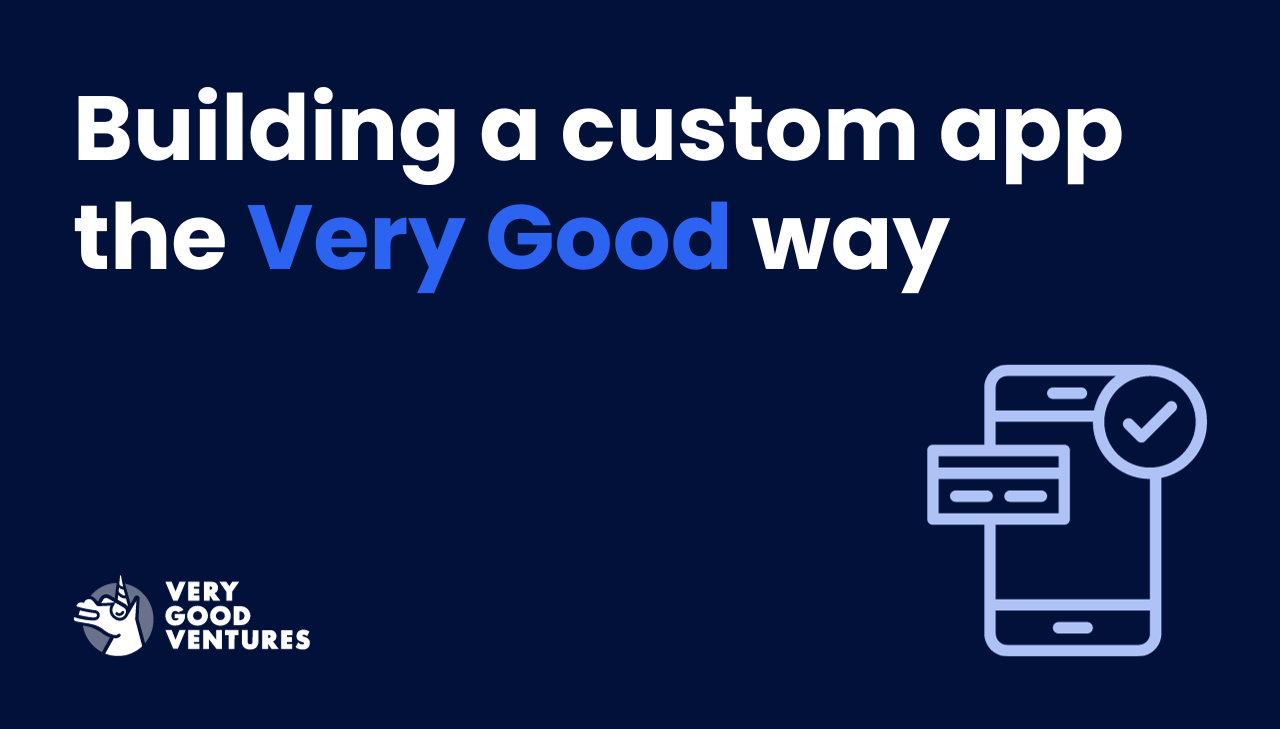How to build a custom app the Very Good way
Learn how an infusion of best practices can help your organization's custom mobile app reach its potential.

If you are trying to build a channel to create a connection with your customers, or want to show off your very good product for e-commerce, you should start thinking about developing a custom mobile app, web app, desktop app, or all of them. You might be asking: Why is software development the right way to reach your audience? In short, custom apps bring your brand a convenient digital space to connect with people.
Building these, you can also alternatively give your own employees a communication tool. In either case, external or internal, your app is a direct, branded channel that lets you set the parameters of the user experience.
But be cautious, not every app project will drive ideal results. You need to approach custom mobile app development with focus and best practices to make sure your software is an actual useful tool for your audience, rather than something they'll simply ignore. And we know that’s not the desired outcome after putting together substantial efforts and a budget when investing in it.
When it's handled in a serious, focused way, custom app development puts your brand in front of a massive user base, allowing you to connect with people across a wide variety of devices, screens and touchpoints, in any channel that makes sense for your brand.
What's the state of custom app development?
Custom app development has become part of the fabric of business. As the tools to develop high-quality custom applications have become more widely available, software has expanded outside the technology field to reach companies of all kinds.
These apps can become the face of the brand, which means these internal software development efforts have to reach a high level of polish, with a heavy focus on user interface design and the overall user experience.
A great custom app development effort will be able to achieve:
- Adoption: Marketing an app launch and ensuring the software has a solid feature set from day one are both important priorities tied to establishing a strong initial user base.
- Usage: Good UI leads to good UX. Features should be optimized to take advantage of a given device and create seamless, convenient experiences.
- Engagement: How do you keep users engaged with your app for the long term? By both correcting bugs and rolling out new capabilities according to a roadmap.
One of the most potentially significant evolutions is the ever-increasing sophistication and power of multi-platform frameworks such as Flutter, which you probably have heard about. These product design and development tools have taken the potentially sprawling and siloed process of app development and focused on it.
To reach the widest possible audience, your custom app development efforts should focus on more than one platform. Even if you're solely interested in custom mobile application development, you'll find your user base fragmented between iOS and Android. Therefore, you have to choose whether to develop natively for each platform or embrace a multi-platform model.
The multi-platform approach is powerful because it allows you to unite your team around a single codebase. A unified codebase means you can deliver full functionality with a lower headcount and proceed more efficiently through both pre-release development and the execution of the app functionality roadmap.
The rise of Flutter and similar frameworks have enabled app developer teams to create powerful, responsive and attractive application experiences without fragmenting teams or duplicating code. Whether you're shifting components of an existing app into Flutter or experimenting with custom app development for the first time, embracing a unified team and monorepo architecture allows you to increase collaboration and code-sharing.
Learn more about the way our experts develop apps.
How do you get started with app development?
The commitment to a development model — single-team or multiple — should be an early consideration in your app development journey. As you prepare to begin active development, you need to consider the purpose of the app and its target audience.
What kinds of platforms do you envision releasing your app on? The more targeted platforms you add, the more time and effort you can save by collapsing the siloed structure and unifying the development team and codebase.
In addition to iOS and Android, other potential platforms include MacOS, Windows, web, and embedded operating systems on custom hardware. Developing for multiple platforms is a compelling reason to use cross-platform tools. Current versions of Flutter enable Mac, PC and web development, allowing you to make the most of these platforms' resources and create a positive user experience.
Before coding gets underway, mobile apps require conceptualization, along with the creation of a product roadmap. The whole journey, from app idea to minimum viable product status, launch and iteration over time should be mapped in advance.
Moving quickly during early pre-launch steps is important. The sooner the app launches, the faster it can start producing a return on your development investment. An app that hasn't launched yet is just a cost center, while one that's available in the market can generate value.
Prioritizing time-to-market over a high-quality mobile app with a good user experience can have devastating consequences. Even at launch, an app must be convenient and pleasant to use. A low-quality experience can drive users away. Operating a single development team that works in a single codebase is a way to shorten the development timeline and get to that ROI, without compromising quality.
Discover why our teams use Flutter for product design and development, and why more companies are doing the same.
How do you manage the development of a custom mobile app?
As custom mobile app development progresses, the team responsible should stick to best practices that allow them to combine quality with speed. A unified team working with a multi-platform framework and a single codebase can be intentional about their approach to development excellence.
App development requires a strong commitment to developing a number of processes, including:
- Developing a reliable backend: A technologically sound codebase built on simple principles enables your app to differentiate itself from the pack by showcasing a reliable and pleasant user experience
- Designing a powerful UI for better UX: A responsive, effective UI that’s optimized for the platforms it appears on can keep users engaged, helping the app stand out from competitors' offerings.
- Incorporating hardware capabilities: While native app development for multiple platforms was traditionally the only way to squeeze more performance out of device hardware, Flutter delivers the same performance by compiling directly to machine code.
- Planning and executing on a roadmap: Having a list of planned features and rolling them out on schedule is a key piece of retaining an engaged audience.
- Marketing the app and orchestrating the launch: Launching an app requires handling numerous tiny details, including listing in the Google Play store and Apple App Store, alongside mobile app marketing.
- Maximizing QA, testing, reporting and analytics: Continuously making impactful updates, revisions and additions to fix bugs and optimize UX over time is just as critical as following the roadmap, and is considerably easier with a unified codebase.
Whether or not you’re developing your first custom software offering, having a strong mobile app development process in place can represent the difference between a successful and disappointing launch.
Read our whitepaper for an in-depth look into the many stages of building an app.
How can you lock in long-term success for your app?
Long-term support for an app represents two distinct kinds of work that can come into conflict with each other, especially because time and resources are always limited. Your team must keep up with bug fixes and quality control while also rolling out new features, either from the roadmap or user' requests.
A single team approach with a unified codebase can be far more effective than running multiple native app development teams. The process of fixing bugs, when split between different codebases and groups with their own practices and priorities, can become unwieldy, slow and expensive.
When simply keeping up with fixes and updates is too demanding, new feature development can easily fall by the wayside. Working with a single codebase becomes a way to enable a promising future for the app. Putting out fires takes less time, which enables growth and scalability.
Ready to start on your next custom mobile app?
If it's time to begin your organization's next mobile app — or to start shifting existing components of custom applications to Flutter for easier updates and scaling going forward — you have a few immediate priorities. Your strategy should reflect market conditions and audience interests, alongside your specific goals for the project.
You don't have to go it alone in the effort to build a custom mobile application. There are third-party experts available to assist your team in a variety of capacities, from consulting and advisory roles to hands-on custom software development work. Connecting with experienced professionals can help you infuse your app development process with best practices.
Insights from Our Experts

Today’s Engineering & Product Leadership: 5 Lessons From Build to Succeed
Lorem ipsum dolor sit amet, consectetur adipiscing elit. Suspendisse varius enim in eros elementum tristique. Duis cursus, mi quis viverra ornare, eros dolor interdum nulla, ut commodo diam libero vitae erat. Aenean faucibus nibh et justo cursus id rutrum lorem imperdiet. Nunc ut sem vitae risus tristique posuere.

How SoFi Scales Mobile Engineering with Flutter and AI
Lorem ipsum dolor sit amet, consectetur adipiscing elit. Suspendisse varius enim in eros elementum tristique. Duis cursus, mi quis viverra ornare, eros dolor interdum nulla, ut commodo diam libero vitae erat. Aenean faucibus nibh et justo cursus id rutrum lorem imperdiet. Nunc ut sem vitae risus tristique posuere.

Mastering CustomPainter in Flutter: From SVGs to Racetracks
Lorem ipsum dolor sit amet, consectetur adipiscing elit. Suspendisse varius enim in eros elementum tristique. Duis cursus, mi quis viverra ornare, eros dolor interdum nulla, ut commodo diam libero vitae erat. Aenean faucibus nibh et justo cursus id rutrum lorem imperdiet. Nunc ut sem vitae risus tristique posuere.


